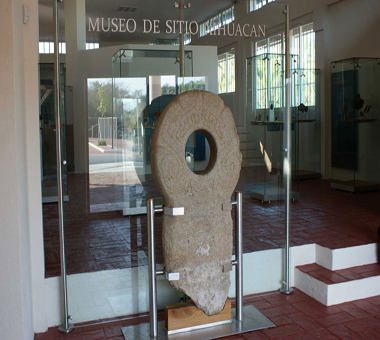Ligas
del sitio
|
| - Home |
| - Tours |
| - Transportation |
| - Testimonials |
| - Photo Gallery |
| - Contact Us |
Xihuacan Archaeological excavation zone
The tour includes: Transportation with good air condition, a tour guide that speaks English and a very good lunch. Taxes and passenger insurances are also included on the price.
On this tour we will visit the Xihuacan site museum, the ball court, the pyramid and the rural community name Soledad de Maciel.
Price for the tour: $65.00 USD.Departure: 9:00 A.M. The tour will last approximately 4 hours and 30 minutes. We pick you up at the lobby of your hotel.
For Lunch you get one of the following choices:
- Chicken on the grill or breaded or chicken fajitas.
- Fish on the grill or breaded or on garlic sauce.
- Shrimp on garlic sauce or breaded.
- Cheese quesadillas.
All of the dishes come with guacamole, chips, beans and a sope. We also bring fresh handmade tortillas, beans and salsa. With lunch you get beer or soft drink.
The tour will be guided by a certified English Speaking guide.
Recommendations: Bring sun block, wear sunglasses, tennis shoes and a hat or cap, and don’t forget your camera!
Note. We have departures everyday except on Monday.
The best is to book a tour a couple of days in advance, but you can also make reservation one day in advance.
To book a tour with us you can do one of the following things:
Send and email to luizito79@yahoo.com.mx.
Click on the contact us link and send and e mail.
Call cell #: 755-111-8028.
Or call cell #: 755-127-9722.
Call office #: 755-553-4271.You can read about the Xihuacan archaeological dig and see some pictures of the area down on this web page.
 |
Xihuacan ceremonial center
Index:
- Meaning
- Location
- Current Situation
- Ethnic Group
- Religion
5.1 Tlaltecuhtli
5.2 Cuitlateca1. Meaning for the Xihuacan term
Literately the meaning for the term “Xihuacan” in the Nahuatl language is: The place for the ones that possess the turquoise, in this case turquoise would translate as “time”, so Xihuacan can be translate as “The place of the people that control the time or calendar”.2. Location
The ceremonial center Xihuacan is located at a small community named Soledad de Maciel (better know as La Chole), the location for the town is approximately at 20 minutes away from Zihuatanejo (to the south), taking highway 200 and at 4 kilometers on a dirt road, the archaeological excavation site is located on Petatlan municipality, which is located on the Costa Grande Region in the state of Guerrero México.3. Current Situation
Nowadays the town of Soledad de Maciel is a community of approximately 500 people, the locals live off agriculture, mainly harvesting coconuts to commercialize the copra, they also grow sweet corn, tobacco and some tropical fruits such as water melons, papayas and mangos, they also fish in the ocean, the ocean is about 2 kilometers away from the community.Just outside Soledad de Maciel there is the Xihuacan Site Museum, it was inaugurated on march 22nd 2011, the museum exhibits more than 800 archaeological pieces from the pre Hispanic time, such as figurines, obsidian vases, works on sea shell, copper axes, bell necklaces, ceramics and lithic, integrates the collection that explains cultural development of the ancient city that had a strong interaction with Teotihuacan during the Classic period (200 to 650 AD).
4. Ethnic Group
The name for the Ethnic group settled in the region was the Cuitlateca, the language spoken was also Cuitlateca, they came to this part of Mesoamercia approximately in the year 2500 before Christ.
5. Religion
They had a polytheistic religion, but they mainly believe in two gods; TLALTECUHTLI and CUITLATECA.5.1 Tlaltecuhtli (Tlal-teh-koo-tlee), for this tribe Tlaltecuhtli was a deity represented as a female, it was the monstrous earth goddess. The earth was represented as the back of a crocodile.
Earth Goddess, it was the deity related to the underworld that devours gods and humans at the end of their life cycle, this is why; it was related to dead and reborn rituals.
On the above image, the monolith has in the center a disc which represents Sun God and in the head there is the Venus planet symbol, it was the main deity for the priestly elite, The Tlaltecuhtli deity symbolizes: knowledge, war and renaissance. The scene carve on the monolith illustrates an event that happens every 8 years, when Venus places over the Sun.
Venus transfers to the Sun God its knowledge and teaches it the way to go, in other words, the priest knowledge was transfer to the God. This monolith was found in the center of the Xihuacan plaza, there were also found stoves, which were used in grate ritual ceremonies.
5.2 Cuitlateca. The meaning of it in Spanish is excrement, which is a synonymous for clay. This deity indicated the main commerce of the town, which was to commercialize and manufacture ceramics (Pottery).
Home • Tours • Contactenos
Up to this moment there have been 52710 visits
to this web site
since the counter was last reset on June 9, 2010.
© 2010
Luis Humberto de la Maza.
Ixtapa Zihuatanejo Gro. México. All Rights reserved.